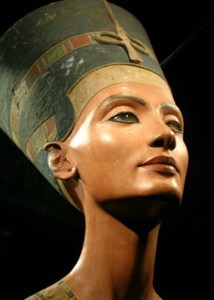
By Jack Beesley
Nefertiti (c.1370 – c.1330 BCE) is one of the most recognisable, yet enigmatic, queens of Ancient Egypt. As the Great Royal Wife of Pharaoh Akhenaten, Nefertiti was a queen of the 18th Dynasty, made famous by the discovery of her bust by German archaeologist Ludwig Borchard.
Nefertiti’s parentage is undetermined, as such, many theories have been proposed to clarify her ancestry.
One often cited theory suggests that Nefertiti was the daughter of Ay, a top advisor who would become Pharaoh some years after Nefertiti’s death as the successor of Tutankhamen, Nefertiti’s stepson.
Another theory proposes that Nefertiti was in fact the biological sister of her husband, Akhenaten, which was customary among Egyptian royals as it was believed to preserve the purity of the royal bloodline.
Nefertiti was the favoured consort of Akhenaten, symbolised by her continuous presence on the walls of the tombs and temples built during his reign. The frequency of Nefertiti’s image is not matched by any other Egyptian queen.
She is depicted as equal in stature to a king, striking Egypt’s enemies and worshiping in the fashion of a Pharaoh, leading to speculation among scholars that Nefertiti was elevated by her husband to co-regent.
In the fifth year of her husband’s reign, Akhenaten initiated a religious revolution – he replaced Egypt’s principal god Amon with the sun god Aton, closed the old state temples, and relocated the court to a tailor-made capital city, Akhetaton.
Nefertiti and Akhenaten had six daughters. This contributed to the celebration of Nefertiti as a fertility goddess. Despite this, Akhenaten took other wives in the hope of producing sons, including his own sister, with whom he fathered the future Tutankhamun.
Nefertiti vanishes from record circa the 12th year of Akhenaten’s reign. This suggests that she died; however, some scholars believe she became her husband’s official co-regent under the name Neferneferuaten.
If Nefertiti maintained power, it is possible she initiated the reversal of her husband’s religious revolution, which would culminate in the reign of King Tut.
Recommended Reading
Joann Fletcher, The Search for Nefertiti (London: Hodder & Stoughton, 2004)
Joyce Tyldesley, Nefertiti: Egypt’s Sun Queen (London: Penguin, 2005).
